Abstract
Objective
Despite platinum-based adjuvant chemotherapy has improved greatly patients’ outcomes, drug resistance poses a major impediment to the successful use of such an effective agent. Metallothioneins(MTs) are known to play putative roles in cancer cell proliferation, apoptosis, differentiation, drug resistance and prognosis. The present studiy was to investigte the role of metallethioein1H(MT1H) in cisplatin resistance of human non-small cell lung cancer(NSCLC) cell lines in vitro or its possible molecular mechanisms.
Methods
MT1H mRNA expression in A549 and A549/DDP cells was detected by RT-PCR. A recombinant eukaryotic expression plasmid pcDNA3.1(-)-MT1H was constructed and transfected into A549 cells which express no MT1H. MT1H siRNA was transfected into A549/DDP cells which express MT1H highly. MT1H expression was detected by RT-PCR and Immunoblot. The chemosensitivity to cisplatin was assessed by MTT assay. Apoptosis rate was determined by Tunel and FCM. Bcl-2 and Bax were determined by immunohistochemistry.
Results
MT1H mRNA was expressed in A549/DDP but not in A549. After transfection of MT1H, MT1H expression was enhanced and the chemosensitivity to cisplatin was decreased in A549 cells. Inversely, after transfection of MT1H siRNA, MT1H expression was decreased and the chemosensitivity to cisplatin was increased in A549/DDP. The apoptosis rate induced by cisplatin was increased and Bcl-2 was down-regulated but Bax showed little change in A549/DDP cells interferred with MT1H siRNA.
Conclusion
MT1H overexpression can promote drug resistance in A549 cells. Down-regulation of MT1H interfered with siRNA can effectively reverses the drug resistance in A549/DDP cells by down-regulating the expression of Bcl-2 and increasing cisplatin induced apoptosis. SiRNA targeting MT1H combined with chemotherapy may be a very promising strategy for treatment of lung cancer.
Similar content being viewed by others
Explore related subjects
Discover the latest articles and news from researchers in related subjects, suggested using machine learning.References
West AK, Stallings R, Hildebrand CE, et al. Human metallothionein genes: structure of the functional locus at 16q13[J]. Genomics 1990; 8: 513–518.
Cherian MG, Huang PC, Klaassen CD, et al. National Cancer Institute workshop on the possible roles of metallothionein in carcinogenesis[J]. Cancer Res 1993; 53:922–925.
Cherian MG, Howell SB, Imura N, et al. Role of metallothionein in carcinogenesis[J]. Toxicol Appl Pharmacol 1994; 126:1–5.
Shimoda R, Achanzar WE, Qu W, et al. Metallothionein is a potential negative regulator of apoptosis[J]. Toxicol Sci 2003; 73: 294–300.
Yamasaki M, Nomura T, Sato F, et al. Metallothionein is up-regulated under hypoxia and promotes the survival of human prostate cancer cells[J]. Oncol Rep 2007; 18:1145–1153.
Bay BH, Jin R, Huang J, et al. Metallothionein as a prognostic biomarker in breast cancer[J]. Exp Biol Med(Maywood) 2006; 231:1516–1521.
Jin R, Chow VT, Tan PH, et al. Metallothionein 2A expression is associated with cell prolifetation in breast cancer[J]. Carcinogenesis 2002; 23: 81–86.
Chun JH, Kim HK, Kim E, et al. Increased expression of metallothionein is associated with irinotecan resistance in gastric cancer[J]. Cancer Res 2004; 64: 4703–4706.
Karin M, Richards RI. Human metallothionein genes-primary structure of the metallothionein-II gene and a related processed gene[J]. Nature 1982; 299: 797–802.
Richards RI, Heguy A, Karin M. Structural and functional analysis of the human metallothionein-IA gene: differential induction by metal ions and glucocorticoids[J]. Cell 1984; 37: 263–272.
Heguy A, West A, Richards RI, et al. Structure and tissue-specific expression of the human metallothionein IB gene[J]. Mol Cell Biol 1986; 6: 2149–2157.
Schmidt CJ, Jubier MF, Hamer DH. Structure and expression of two human metallothionein-I isoform genes and a related pseudogene[J]. J Biol Chem 1985; 260: 7731–7737.
Varshney U, Jahroudi N, Foster R, et al. Structure, organization, and regulation of human metallothionein IF gene: differential and cell-type-specific expression in response to heavy metals and glucocorticoids[J]. Mol Cell Biol 1986; 6: 26–37.
Stennard FA, Holloway AF, Hamilton J, et al. Characterisation of six additional human metallothionein genes[J]. Biochim Biophys Acta 1994; 1218: 357–365.
Palmiter RD, Findley SD, Whitmore TE, et al. MT-III, a brain-specific member of the metallothionein gene family[J]. Proc Natl Acad Sci USA 1992; 89: 6333–6337.
Quaife CJ, Findley SD, Erickson JC, et al. Induction of a new metallothionein isoform (MT-IV) occurs during differentiation of stratified squamous epithelia[J]. Biochemistry 1994; 33: 7250–7259.
Kägi JH, Schäffer A. Biochemistry of metallothionein [J]. Biochemistry 1988; 27: 8509–8515.
Bylander JE, Li SL, Sens MA, et al. Exposure of human proximal tubule cells to cytotoxic levels of CdC12 induces the additional expression of metallothionein 1A mRNA[J]. Toxicol Lett 1995; 76: 209–217.
Xia H, Mao Q, Paulson HL, et al. siRNA-mediated gene silencing in vitro and in vivo[J]. Nat Biotechnol 2002; 20: 1006–1010.
Duxbury MS, Ito H, Benoit E, et al. RNA interference targeting focal adhesion kinase enhances pancreatic adenocarcinoma gemcitabine chemosensitivity[J]. Biochem Biophys Res Commun 2003; 311: 786–792.
Filleur S, Courtin A, Ait-Si-Ali S, et al. SiRNA-mediated inhibition of vascular endothelial growth factor severely limits tumor resistance to antiangiogenic thrombospondin-1 and slows tumor vascularization and growth[J]. Cancer Res 2003; 63: 3919–3922.
Wang D, Lippard SJ. Cellular processing of platinum anticancer drugs[J]. Nat Rev Drug Discov 2005; 4: 307–320.
Zunino F, Perego P, Pilotti S, et al. Role of apoptotic response in cellular resistance to cytotoxic agents[J]. Pharmacol Ther 1997; 76: 177–185.
Reed JC. Mechanisms of apoptosis avoidance in cancer[J]. Curr Opin Oncol 1999; 11: 68–75.
Reed JC. Double identity for proteins of the Bcl-2 family[J]. Nature 1997; 387: 773–776.
Estève MA, Carré M, Bourgarel-Rey V, et al. Bcl-2 down-regulation and tubulin subtype composition are involved in resistance of ovarian cancer cells to vinflunine[J]. Mol Cancer Ther 2006; 5: 2824–2833.
McCurrach ME, Connor TM, Knudson CM, et al. Bax-deficiency promotes drug resistance and oncogenic transformation by attenuating p53-dependent apoptosis[J]. Proc Natl Acad Sci USA 1997; 94: 2345–2349.
Author information
Authors and Affiliations
Corresponding author
Additional information
This work was supported by the grants from State Key Basic Research “973” Programs of China (2002CB513101 and 2004BC518701)
Rights and permissions
About this article
Cite this article
Hou, Xf., Fan, Qx., Wang, Lx. et al. Role of metallothionein1h in cisplatin resistance of non-small cell lung cancer cells. Chin. J. Cancer Res. 21, 247–254 (2009). https://doi.org/10.1007/s11670-009-0247-9
Received:
Accepted:
Published:
Issue Date:
DOI: https://doi.org/10.1007/s11670-009-0247-9




